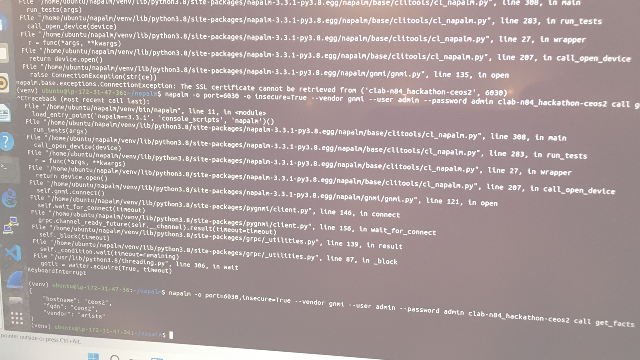Worth Reading: Performance Testing of Commercial BGP Stacks
For whatever reason, most IT vendors attach “you cannot use this for performance testing and/or publish any results” caveat to their licensing agreements, so it’s really hard to get any independent test results that are not vendor-sponsored and thus suitably biased.
Justin Pietsch managed to get a permission to publish test results of Junos container implementation (cRPD) – no surprise there, Junos outperformed all open-source implementations Justin tested in the past.
What about other commercial BGP stacks? Justin did the best he could: he published Testing Commercial BGP Stacks instructions, so you can do the measurements on your own.
Worth Reading: Performance Testing of Commercial BGP Stacks
For whatever reason, most IT vendors attach “you cannot use this for performance testing and/or publish any results” caveat to their licensing agreements, so it’s really hard to get any independent test results that are not vendor-sponsored and thus suitably biased.
Justin Pietsch managed to get a permission to publish test results of Junos container implementation (cRPD) – no surprise there, Junos outperformed all open-source implementations Justin tested in the past.
What about other commercial BGP stacks? Justin did the best he could: he published Testing Commercial BGP Stacks instructions, so you can do the measurements on your own.
#NANOG84 Hackathon: No plan survives first contact with go-getter students
Austin, 12–13 February 2022

So there I was, ready to do battle in my blue corner of the ring. Together with Anton Karneliuk from Karneliuk.com — author of pyGNMI among other things — we got started on a multi-vendor NAPALM driver using gNMI as a backend.
Working around the clock in our different time zones, in full blown follow-the-moon style, we managed to get a basic NAPALM get_facts working for both Arista cEOS and Nokia SR Linux, at some point late Saturday night.

Working together to build the Internet of tomorrow®
On Sunday a group of students from University of Colorado Boulder joined the party, and it quickly became apparent that our hacking plans would have to change. Because important as multi-vendor compatibility issues are, inter-generation transfer of knowledge is even more critical. We already barely understand the networks we have built today — how could we ever expect the next generation to keep things running if we don’t help them understand what we did?
Long story short: I teamed up with Dinesh Kumar Palanivelu and he ended up submitting his first Pull Request: A small step for a man, but a huge win for the NANOG community!
Thanks again Continue reading
Rust Notes: Traits
A trait in Rust is similar to an interface in other languages. Traits define the required behaviour a type MUST implement to satisfy the trait (interface). // Structs that implement the `Greeter` trait. struct Person struct Dog } // Implement the `Greeter` trait for the...continue reading
Rust Notes: Structs
A struct in Rust is used to encapsulate data. structs can have fields, associated functions and methods. // Instantiate an immutable struct. let sat = StuffAndThings Associated Function Associated functions are tied to an instance of a struct and are usually used as...continue reading
Rust Notes: Traits
A trait in Rust is similar to an interface in other languages. Traits define the required behaviour a type MUST implement to satisfy the trait (interface). // Structs that implement the `Greeter` trait. struct Person struct Dog } // Implement the `Greeter` trait for the...continue reading
Heavy Networking 618: Building Virtual Networks With Console Connect (Sponsored)
On today’s Heavy Networking episode we talk with sponsor Console Connect, which provides software-defined interconnections for enterprises and service providers. Guests Paul Gampe and Jay Turner dig into the Console Connect catalog, including Internet On-Demand, CloudRouter, and some of the interesting partner integrations that provide unique connectivity options.
The post Heavy Networking 618: Building Virtual Networks With Console Connect (Sponsored) appeared first on Packet Pushers.
Heavy Networking 618: Building Virtual Networks With Console Connect (Sponsored)
On today’s Heavy Networking episode we talk with sponsor Console Connect, which provides software-defined interconnections for enterprises and service providers. Guests Paul Gampe and Jay Turner dig into the Console Connect catalog, including Internet On-Demand, CloudRouter, and some of the interesting partner integrations that provide unique connectivity options.CDP Discovery Using Microsoft’s PKTMON
In this video, I review how to use Microsoft pktmon commands to figure out what port I am connected to without using Wireshark.Technical Debt or Underperforming Investment?

In this week’s issue of the Packet Pushers Human Infrastructure newsletter, there was an excellent blog post from Kam Lasater about how talking about technical debt makes us sound silly. I recommend you read the whole thing because he brings up some very valid points about how the way the other departments of the organization perceive our issues can vary. It also breaks down debt in a very simple format that takes it away from a negative connotation and shows how debt can be a leverage instrument.
To that end, I want to make a modest proposal to help the organization understand the challenges that IT faces with older systems and integration challenges. Except we need some new branding. So, I propose we start referring to technical debt as “underperforming technical investments”.
I’d Buy That For A Dollar
Technical debt is just a clever way to refer to the series of layered challenges we face from decisions that were made to accomplish tasks. It’s a burden we carry negatively throughout the execution of our job because it adds extra time to the process. We express it as debt because it’s a price that must be paid every time we need Continue reading
Detecting Magecart-Style Attacks With Page Shield


During CIO week we announced the general availability of our client-side security product, Page Shield. Page Shield protects websites’ end users from client-side attacks that target vulnerable JavaScript dependencies in order to run malicious code in the victim’s browser. One of the biggest client-side threats is the exfiltration of sensitive user data to an attacker-controlled domain (known as a Magecart-style attack). This kind of attack has impacted large organizations like British Airways and Ticketmaster, resulting in substantial GDPR fines in both cases. Today we are sharing details of how we detect these types of attacks and how we’re going to be developing the product into the future.
How does a Magecart-style attack work?
Magecart-style attacks are generally quite simple, involving just two stages. First, an attacker finds a way to compromise one of the JavaScript files running on the victim’s website. The attacker then inserts malicious code which reads personally identifiable information (PII) being entered by the site’s users, and exfiltrates it to an attacker-controlled domain. This is illustrated in the diagram below.

Magecart-style attacks are of particular concern to online retailers with users entering credit card details on the checkout page. Forms for online banking are also high-value Continue reading
netsim-tools on the Modem Podcast
A few weeks ago, Nick Buraglio and Chris Cummings invited me for an hour-long chat about netsim-tools on the Modem Podcast.
We talked about why one might want to use netsim-tools instead of another lab orchestration solution and the high-level functionality offered by the tool. Nick particularly loved its IPAM features which got so extensive in the meantime that I had to write a full-blown addressing tutorial. But there’s so much more: you can also get a fully configured OSPFv2, OSPFv3, EIGRP, IS-IS, SRv6, or BGP lab built from more than a dozen different devices. In short (as Nick and Chris said): you can use netsim-tools to make labbing less miserable.
netsim-tools (now netlab) on the Modem Podcast
A few weeks ago, Nick Buraglio and Chris Cummings invited me for an hour-long chat about netlab on the Modem Podcast1.
We talked about why one might want to use netlab instead of another lab orchestration solution and the high-level functionality offered by the tool. Nick particularly loved its IPAM features which got so extensive in the meantime that I had to write a full-blown addressing tutorial. But there’s so much more: you can also get a fully configured OSPFv2, OSPFv3, EIGRP, IS-IS, SRv6, or BGP lab built from more than a dozen different devices. In short (as Nick and Chris said): you can use netlab to make labbing less miserable.
-
netlab was known as netsim-tools when we were recording that podcast. ↩︎
Calico Cloud: Active Build and Runtime Security for Cloud-Native Applications
Calico Cloud has just celebrated its 1-year anniversary! And what better way to celebrate than to launch new features and capabilities that help users address their most urgent cloud security needs.
Over the past year, the Tigera team has seen rapid adoption of Calico Cloud for security and observability of cloud-native applications. With this new release, Calico Cloud becomes the first in the industry to offer the most comprehensive active cloud-native application security that goes beyond detecting threats to limit exposure and automatically mitigate risks in real time.
With news of new zero-day threats emerging almost every day (e.g. Argo CD, Chrome Browser), the current security approach needs to evolve. We need active build, deploy, and runtime security, all together, instead of using a siloed approach. Security threats, vulnerabilities, and risks for all three areas should be addressed together, by the same security platform, rather than using multiple disjointed tools. Calico Cloud does just that!
With Calico Cloud, you can reduce your cloud-native application’s attack surface, harness machine learning to combat runtime security risks from known and unknown zero-day threats, enable continuous compliance, and prioritize and mitigate the risks from vulnerabilities and attacks.
Let’s take a look Continue reading